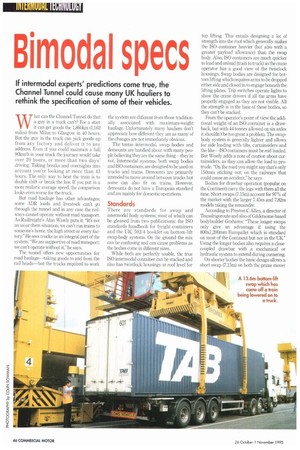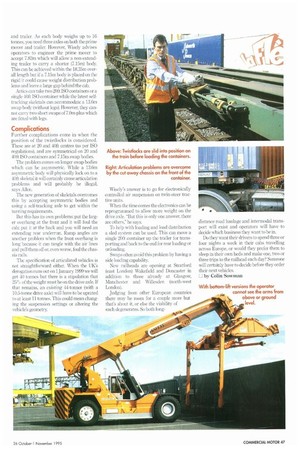Bimodal specs
Page 48

Page 49

If you've noticed an error in this article please click here to report it so we can fix it.
If intermodal experts' predictions come true, the Channel Tunnel could cause many UK hauliers to rethink the specification of some of their vehicles.
What can the Channel Tunnel do that a guy in a truck can't? For a start it can get goods the 1,860km (1,162 miles) from Milan to Glasgow in 40 hours. But the guy in the truck can pick goods up from any factory and deliver it to any address. Even if you could maintain a full 90km/h in your truck the journey would take over 20 hours, or more than two days' driving. Taking breaks and overnights into account you're looking at more than 43 hours. The only way to beat the train is to double shift or break the law. If you put in a more realistic average speed, the comparison looks even worse for the truck.
But road haulage has other advantages: some ADR loads and livestock can't go through the tunnel and in any case the railways cannot operate without road transport. As Railfreight's Alan Wisely puts it: "It's not an us-or-them situation: we can't run trains to someone's home, the high street or every factory." He sees trucks as an integral part of the system. We are supportive of road transport; we can't operate without it," he says.
The tunnel offers new opportunities for road haulage—taking goods to and from the rail heads—but the trucks required to work the system are different from those traditionally associated with maximum-weight haulage. Unfortunately many hauliers don't appreciate how different they are as many of the changes are not immediately obvious.
The terms intermodal, swap bodies and demounts are bandied about with many people believing they are the same thing—they're not. Intermodal systems, both swap bodies and ISO containers, are designed to be used on trucks and trains. Demounts are primarily intended to move around between trucks but some can also fit on trains. However, demounts do not have a European standard and are mainly for domestic operations
Standards
There are standards for swap and intermodal body systems, most of which can be gleaned from two publications: the ISO standards handbook for freight containers and the UIC 592/4 booklet on bottom-lift swap-body systems. On the ground the mix can be confusing and can cause problems as the bodies come in different sizes.
While both are perfectly usable, the true ISO intermodal container can be stacked and also has twistlock housings at roof level for top lifting. This entails designing a lot of strength into the roof which generally makes the ISO container heavier (but also with a greater payload allowance) than the swap body. Also, ISO containers are much quicker to load and unload (train to truck) as the crane operator has a good view of the twistlock housings. Swap bodies are designed for bottom lifting which requires arms to be dropped either side and closed in to engage beneath the lifting plates. Trip switches operate lights to show the crane drivers if all the arms have properly engaged as they are not visible. All the strength is in the base of these bodies, so they can't be stacked.
From the operator's point of view the additional weight of an ISO container is a drawback, but with 44 tonnes allowed on six axles it shouldn't be too great a problem. The swapbody system is generally lighter and allows for side loading with tilts, curtainsiders and the like—ISO containers must be end loaded. But Wisely adds a note of caution about curtainsiders, as they can allow the load to protrude. "On the road you might say that's only 150mm sticking out; on the railways that could cause an accident," he says Bodies for drawbar operation (popular on the Continent) carry the legs with them all the time. Short swaps (7.15m) account for 97% of the market with the larger 7.45m and 7.82m models taking the remainder.
According to Preston C Allen, a director of Transfrigoroute and also of Gildersome-based bodybuilder Grahams: "These longer swaps only give an advantage if using the 800x1,200mm Europallet which is standard on most of the Continent but not in the UK." Using the longer bodies also requires a closecoupled drawbar with a mechanical or hydraulic system to extend during cornering.
On shorter bodies the basic design allows a short swap (7.15m) on both the prime mover and trailer. As each body weighs up to 16 tonnes, you need three axles on both the prime mover and trailer. However, Wisely advises operators to engineer the prime mover to accept 7.82m which will allow a non-extending trailer to carry a shorter (7.15m) body. This can be achieved within the 18.35m overall length but if a 7.15m body is placed on the rigid it could cause weight distribution problems and leave a large gap behind the cab.
Art ics can take two 20ft ISO containers or a single 40ft ISO container while the latest selftracking skeletals can accommodate a 13.6m swap body (without legs). However, they cannot carry two short swaps of 7.0m-plus which are fitted with legs.
Complications
Further complications come in when the position of the twistlocks is considered. These are at 20 and 40ft centres (as per ISO regulations), and are symmetrical on 20 and 40ft ISO containers and 7.15m swap bodies.
The problem comes on longer swap bodies Which can be asymmetric. While a 13.6m asymmetric body will physically lock on to a 40ft skeletal it will certainly cause articulation problems and will probably be illegal, says Allen.
The new generation of skeletals overcomes this by accepting asymmetric bodies and using a self-tracking axle to get within the turning requirements.
But this has its own problems: put the larger overhang at the front and it will foul the cab; put it at the back and you will need an extending rear underrun. Ramp angles are another problem when the front overhang is long because it can tangle with the air lines and pull them off or, even worse, foul the chassis rails.
The specification of articulated vehicles is not straightforward either. When the UK's derogation runs out on 1 January 1999 we will get 40 tonnes but there is a stipulation that 25", of the weight must be on the drive axle. If that remains, an existing 44-tanner (with a 10.5-tonne drive axle) will have to be uprated to at least 11 tonnes. This could mean changing the suspension settings or altering the vehicle's geometry Wisely's answer is to go for electronically controlled air suspension on twin-steer tractive units.
When the time comes the electronics can be reprogrammed to allow more weight on the drive axle. "But this is only one answer, there are others," he says.
To help with loading and load distribution a sled system can be used. This can move a single 20ft container up the trailer for transporting and back to the end for rear loading or unloading.
Swaps often avoid this problem by having a side loading capability.
New railheads are opening at Stratford (east London) Wakefield and Doncaster in addition to those already at Glasgow, Manchester and Willesden (north-west London).
Judging from other European countries there may be room for a couple more but that's about it, or else the viability of each degenerates. So both long distance road haulage and intermodal transport will exist and operators will have to decide which business they want to be in.
Do they want their drivers to spend three or four nights a week in their cabs travelling across Europe, or would they prefer them to sleep in their own beds and make one, two or three trips to the railhead each day? Someone will certainly have to decide before they order their next vehicles.
Li by Colin Sowman With bottom-lift versions the operator cannot see the arms from above or ground level.












































































































































